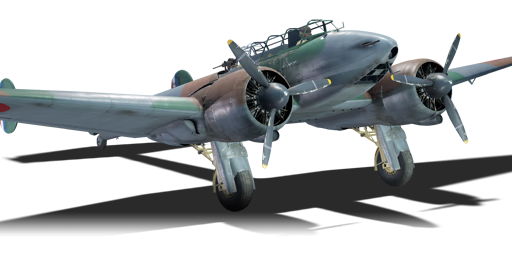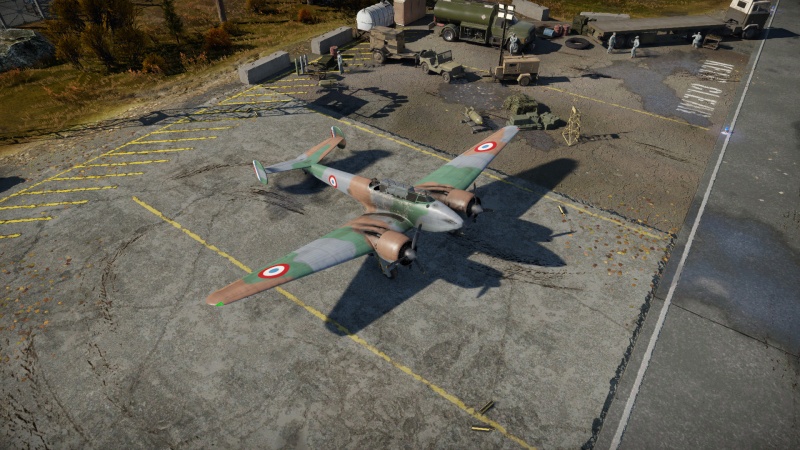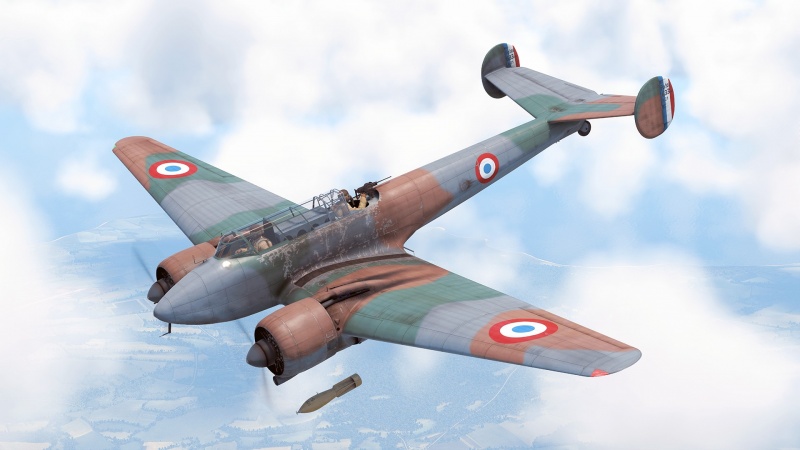Potez 633
| This page is about the French bomber Potez 633. For other versions, see Potez 630 and Potez 631. |
Contents
Description
The Potez 633 was the light bomber variant of the Potez 63 family of aircraft. It had a two man configuration, with a pilot and rear gunner. The aircraft proved to be relatively ineffective as a bomber in the Battle of France, suffering heavy losses due to enemy air superiority and the mediocre speed of the Potez 633, a problem shared with its interceptor counterparts, the Potez 630 and 631. While other nations such as China, Romania, and Greece also used the Potez, not all of them were delivered due to a French embargo on army equipment and other military assets in June 1939. The aircraft also served with Vichy France, although relegated to second line service.
Introduced in Update 1.73 "Vive la France", the Potez 633 lacks the 20 mm cannons and additional 7.5 mm MGs for offensive armament compared to the Potez 630 and 631, instead having a single 7.5 mm MG mounted in the nose. The aircraft has adequate ordnance for a light bomber of its BR, being capable of carrying a total of 400 kg of bombs in the form of eight 50 kg or two 200 kg bombs. The 200 kg bombs are the most adequate for dealing with ground targets, and can be used with good results in ground battles against light tanks. It should be noted that the Potez is particularly weak against SPAA due to its low speed and large size when compared to biplanes or ground attackers.
General info
Flight performance
| Characteristics | Max Speed (km/h at 4,000 m) |
Max altitude (metres) |
Turn time (seconds) |
Rate of climb (metres/second) |
Take-off run (metres) | |||
|---|---|---|---|---|---|---|---|---|
| AB | RB | AB | RB | AB | RB | |||
| Stock | 421 | 403 | 9500 | 21.2 | 22.3 | 4.4 | 4.2 | 350 |
| Upgraded | 462 | 440 | 18.9 | 20.0 | 10.9 | 7.3 | ||
Details
| Features | ||||
|---|---|---|---|---|
| Combat flaps | Take-off flaps | Landing flaps | Air brakes | Arrestor gear |
| ✓ | ✓ | ✓ | X | X |
| Limits | ||||||
|---|---|---|---|---|---|---|
| Wings (km/h) | Gear (km/h) | Flaps (km/h) | Max Static G | |||
| Combat | Take-off | Landing | + | - | ||
| 710 | 295 | 346 | 329 | 240 | ~10 | ~7 |
| Optimal velocities (km/h) | |||
|---|---|---|---|
| Ailerons | Rudder | Elevators | Radiator |
| < 360 | < 360 | < 330 | > 320 |
Survivability and armour
- No armour plating
- No armour glazing
- Critical components located in front of aircraft (fuel, pilot, engine, controls)
Modifications and economy
Armaments
Offensive armament
The Potez 633 is armed with:
- 1 x 7.5 mm MAC 1934 machine gun, nose-mounted (500 rpg)
Suspended armament
The Potez 633 can be outfitted with the following ordnance:
- 8 x 50 kg G.A. MMN. 50 bombs (400 kg total)
- 2 x 100 kg No.1 bombs (200 kg total)
- 2 x 200 kg No.1 bombs (400 kg total)
Defensive armament
The Potez 633 is defended by:
- 1 x 7.5 mm MAC 1934 machine gun, dorsal turret (1,000 rpg)
Usage in battles
The Potez 633's light bomb load (when compared to the Farman monsters that preceded it) makes this aircraft much more dependent on skill when dropping ordnance. When facing light vehicles, the 8x50kg load is particularly useful, allowing you to tag along with the larger bombers and clean up after their pass. Use the 7.5 mm MG in the nose to clean up any stray SPAA trucks in your path... A short burst will usually be rewarded with a kill. Use the bombs on anything else that moves.
The 633 is also not as agile as other twin-engine aircraft its size, avoid turn fighting no matter how tempting. Just make a quick snapshot at passing fighters as they cross your path and keep moving to your next target. Keep an eye on your six, the rear gunner with the 7.5 mm MAC machine gun may deter lighter aircraft like Reserve fighters, but any rank II fighter which winds up on your tail usually means a one-way ticket to the ground in a heap unless a teammate is nearby who can help.
Manual Engine Control
| MEC elements | ||||||
|---|---|---|---|---|---|---|
| Mixer | Pitch | Radiator | Supercharger | Turbocharger | ||
| Oil | Water | Type | ||||
| Controllable | Not controllable Not auto controlled |
Controllable Not auto controlled |
Controllable Not auto controlled |
Separate | Not controllable 1 gear |
Not controllable |
Pros and cons
Pros:
- Has offensive armament unlike most other bombers
- Relatively tough due to very slim airframe, deflects bullets easily from behind
- Surprisingly decent energy retention
- Bomb load good for taking out armored cars and vehicle strips
- Easy to fly
- Good overall flight characteristics
Cons:
- Meagre defensive and offensive armament
- Poor bomb load
- Both of the above two points makes it difficult to do much damage with this aircraft.
- Poor manoeuvrability
- Dorsal gunner has a limited range of motion
History
The Potez 633 was one of the numerous derivatives of the Potez 63. It was a light bomber, and it had a two-man crew: a pilot and a rear gunner. A contract for the production of 115 aircraft was awarded to SNCAN by the French Air Force. In 1938 though, it was decided that the light bombers had to have a crew of three, and the contract was cancelled. Nevertheless, the Potez 633 was offered for export with some success: Greece bought twenty-four aircraft, China bought four, Romania ordered forty and the Swiss air force bought one.
The Munich crisis showed that the French army lacked modern equipment and export war material deliveries were embargoed by the French government in June 1939. The Potez 633 built for export and not yet delivered to their customers were transferred to the French air force. These aircraft were used by ground attack units for pilot training until better aircraft could replace them.
In May 1940, at the moment of the German attack some ground attack units were still equipped with the Potez 633. These aircraft attacked the German columns, suffering heavy losses due to both enemy fighters patrolling the area and anti-aircraft fire from below.
Only thirteen Potez 633s were delivered to the Greek air force before the embargo. They accomplished reconnaissance missions over Albania during the Italian invasion, a few aircraft being downed by Italian fighters. Ultimately, all the remaining Potez were destroyed during the German invasion of Greece.
A total of twenty Potez 633s were delivered to Romania before the June 1939 embargo. These aircraft were reinforced by nine others handed over by Vichy France in 1941. They started their combat operations the day of the Romanian declaration of war to the USSR, in June 1941. The Potez 633s supported the Romanian ground forces, notably during the siege of Odessa and the battle of Stalingrad. In December 1942, the remaining aircraft returned to Romania, and they finished their careers as trainer aircraft for pilots training to be night fighters.
Media
- Skins
See also
- Related development
- Aircraft of comparable role, configuration and era
External links
| Potez (SNCAN) | |
|---|---|
| Fighters | Potez 630 · Potez 631 |
| Bombers | Potez 633 |
| France bombers | |
|---|---|
| Farman | F.222.2 · N.C.223.3 |
| Latécoère | Late 298D |
| Potez | Potez 633 |
| Liore et Olivier | LeO 451 early · LeO 451 late |
| Bloch | M.B.174A-3 · M.B.162 · M.B.175T |
| American | V-156-F · Martin 167-A3 · ▄A-35B · ▄SB2C-5 · B-26C · ▄PBY-5A Late · ▄PB4Y-2 |
| British | Lancaster MR.7 |






